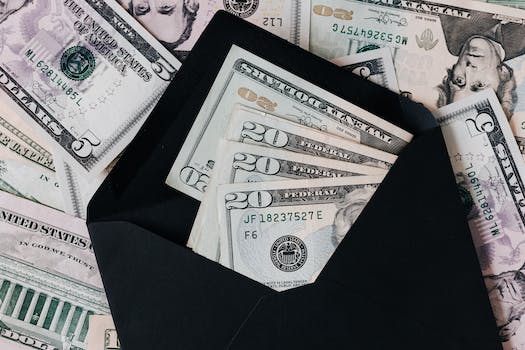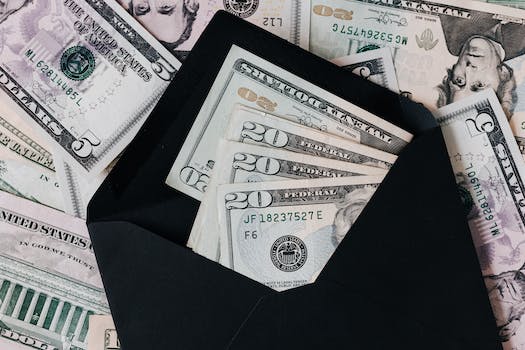How To Save Money Bank
“Maximize your savings with our expert tips and tricks.”
Introduction
Introduction: Saving money is an essential aspect of financial planning. It helps you to achieve your financial goals and secure your future. One of the best ways to save money is by using a bank account. Banks offer various savings accounts that provide interest on your deposits, helping your money grow over time. In this article, we will discuss how to save money in a bank and some tips to maximize your savings.
5 Simple Tips for Building Your Savings Account
Saving money can be a daunting task, especially when you have bills to pay and a limited income. However, building a savings account is crucial for financial stability and achieving your long-term goals. Here are five simple tips for saving money and building your savings account.
1. Create a Budget
The first step to saving money is creating a budget. A budget helps you track your income and expenses, and identify areas where you can cut back on spending. Start by listing all your sources of income and fixed expenses such as rent, utilities, and loan payments. Then, track your variable expenses such as groceries, entertainment, and transportation. Once you have a clear picture of your finances, you can identify areas where you can reduce your spending and allocate more money towards your savings account.
2. Set Savings Goals
Setting savings goals is a great way to motivate yourself to save money. Whether you want to save for a down payment on a house, a vacation, or an emergency fund, having a specific goal in mind can help you stay focused and committed to saving. Start by setting a realistic savings goal and break it down into smaller, achievable milestones. For example, if you want to save $10,000 in a year, you can aim to save $833 per month or $208 per week.
3. Automate Your Savings
Automating your savings is a simple and effective way to build your savings account. Many banks offer automatic transfer services that allow you to transfer a fixed amount of money from your checking account to your savings account on a regular basis. You can set up a weekly, bi-weekly, or monthly transfer that fits your budget and savings goals. By automating your savings, you can ensure that you are consistently putting money towards your savings account without having to think about it.
4. Reduce Your Expenses
Reducing your expenses is another way to save money and build your savings account. Look for ways to cut back on your variable expenses such as eating out less, using coupons, and shopping for deals. You can also consider switching to a cheaper cell phone plan, canceling subscriptions you don’t use, and negotiating lower rates on your bills. By reducing your expenses, you can free up more money to put towards your savings account.
5. Earn Extra Income
Finally, earning extra income is a great way to boost your savings account. There are many ways to earn extra money such as freelancing, selling items you no longer need, and taking on a part-time job. You can also consider starting a side hustle such as tutoring, pet-sitting, or house cleaning. By earning extra income, you can increase your savings rate and reach your savings goals faster.
In conclusion, building a savings account is an important step towards financial stability and achieving your long-term goals. By creating a budget, setting savings goals, automating your savings, reducing your expenses, and earning extra income, you can save money and build your savings account. Remember, saving money takes time and effort, but the rewards are worth it in the end.
Maximizing Your Interest Rates: How to Choose the Right Savings Account
Saving money is an essential part of financial planning. Whether you’re saving for a rainy day, a big purchase, or your retirement, it’s important to make the most of your savings. One way to do this is by choosing the right savings account. With so many options available, it can be overwhelming to decide which one is best for you. In this article, we’ll discuss how to choose the right savings account to maximize your interest rates and save money.
First, it’s important to understand the different types of savings accounts. The most common types are traditional savings accounts, high-yield savings accounts, and money market accounts. Traditional savings accounts are offered by most banks and credit unions and typically have lower interest rates. High-yield savings accounts, on the other hand, offer higher interest rates but may require a higher minimum balance or have other restrictions. Money market accounts are similar to high-yield savings accounts but may offer even higher interest rates and more flexibility.
When choosing a savings account, consider your financial goals and how much money you plan to save. If you’re saving for a short-term goal, such as a vacation or a down payment on a house, a traditional savings account may be sufficient. However, if you’re saving for a long-term goal, such as retirement, a high-yield savings account or money market account may be a better option.
Next, consider the interest rates and fees associated with each account. Interest rates can vary widely between different savings accounts, so it’s important to compare rates before choosing an account. Look for accounts with the highest interest rates and the lowest fees. Some accounts may also offer bonuses or other incentives for opening an account or maintaining a certain balance.
Another factor to consider is the accessibility of your savings. Some accounts may have restrictions on how often you can withdraw money or may charge fees for early withdrawals. If you anticipate needing to access your savings frequently, look for an account with no or low withdrawal fees.
Finally, consider the reputation and stability of the bank or credit union offering the account. Look for a bank or credit union with a strong financial history and good customer reviews. You want to be sure that your savings are safe and secure.
In summary, choosing the right savings account is an important part of maximizing your interest rates and saving money. Consider your financial goals, the interest rates and fees associated with each account, the accessibility of your savings, and the reputation and stability of the bank or credit union offering the account. By doing your research and choosing the right account, you can make the most of your savings and achieve your financial goals.
The Benefits of Automatic Savings Plans
Saving money can be a daunting task, especially when you have bills to pay and other expenses to take care of. However, it is essential to save money for emergencies, retirement, and other long-term goals. One of the best ways to save money is by setting up an automatic savings plan. In this article, we will discuss the benefits of automatic savings plans and how you can set one up.
An automatic savings plan is a system that automatically transfers a specific amount of money from your checking account to your savings account on a regular basis. This system ensures that you save money without having to think about it actively. The benefits of automatic savings plans are numerous.
Firstly, automatic savings plans help you save money consistently. When you set up an automatic savings plan, you commit to saving a specific amount of money regularly. This consistency helps you build a savings habit, which is essential for achieving your long-term financial goals.
Secondly, automatic savings plans help you save money without feeling the pinch. When you manually transfer money from your checking account to your savings account, you may feel the pinch of the reduced balance in your checking account. However, with an automatic savings plan, the money is transferred automatically, and you don’t feel the pinch.
Thirdly, automatic savings plans help you save money without thinking about it. When you manually transfer money to your savings account, you have to remember to do it regularly. However, with an automatic savings plan, the system does the work for you, and you don’t have to think about it.
Fourthly, automatic savings plans help you save money without the temptation to spend it. When you manually transfer money to your savings account, you may be tempted to spend it on something else. However, with an automatic savings plan, the money is transferred automatically, and you don’t have the temptation to spend it.
Now that we have discussed the benefits of automatic savings plans let’s look at how you can set one up. The first step is to choose a savings account that offers automatic transfers. Most banks offer this service, and you can set it up online or by visiting a branch.
The second step is to decide how much money you want to save regularly. You can start small and increase the amount as you get comfortable with the system. It is essential to choose an amount that you can comfortably afford without affecting your other expenses.
The third step is to choose the frequency of the transfers. You can choose to transfer money weekly, bi-weekly, or monthly, depending on your preference. It is essential to choose a frequency that works for you and your budget.
The fourth step is to set up the automatic transfer. You can do this online or by visiting a branch. You will need to provide your bank account details and the amount and frequency of the transfer.
In conclusion, automatic savings plans are an excellent way to save money consistently without feeling the pinch. They help you build a savings habit, save money without thinking about it, and avoid the temptation to spend it. Setting up an automatic savings plan is easy, and you can do it online or by visiting a branch. Start small and increase the amount as you get comfortable with the system. With an automatic savings plan, you can achieve your long-term financial goals and enjoy financial freedom.
Cutting Costs: How to Reduce Your Monthly Expenses
Saving money is a goal that many people have, but it can be difficult to know where to start. One of the best ways to save money is by cutting costs and reducing your monthly expenses. In this article, we will discuss some tips and tricks for how to save money at the bank.
First and foremost, it is important to understand the fees associated with your bank account. Many banks charge monthly maintenance fees, ATM fees, and overdraft fees. These fees can add up quickly and eat away at your savings. To avoid these fees, consider switching to a bank that offers free checking accounts or waives fees if you meet certain requirements, such as maintaining a minimum balance or setting up direct deposit.
Another way to save money at the bank is by taking advantage of rewards programs. Many banks offer cash back or points for using your debit card or credit card for purchases. These rewards can add up over time and be redeemed for cash or other prizes. Just be sure to read the fine print and understand any limitations or restrictions on the rewards program.
If you have a savings account, consider setting up automatic transfers from your checking account. This will help you save money without even thinking about it. You can set up a weekly or monthly transfer to your savings account, and watch your savings grow over time. Additionally, some banks offer higher interest rates on savings accounts if you maintain a certain balance or make regular deposits.
When it comes to loans and credit cards, it is important to shop around for the best rates and terms. Many banks offer competitive rates on personal loans and credit cards, but it is important to read the fine print and understand any fees or penalties associated with these products. Additionally, consider paying off high-interest debt first, such as credit card debt, to save money on interest charges.
Finally, consider using online banking and mobile apps to manage your accounts. Many banks offer these services for free, and they can help you keep track of your spending, pay bills, and transfer money between accounts. Additionally, some banks offer budgeting tools and financial planning resources to help you save money and reach your financial goals.
In conclusion, there are many ways to save money at the bank. By understanding the fees associated with your account, taking advantage of rewards programs, setting up automatic transfers, shopping around for loans and credit cards, and using online banking and mobile apps, you can reduce your monthly expenses and reach your savings goals. Remember, every little bit counts, so start small and watch your savings grow over time.
The Importance of Budgeting: How to Create and Stick to a Budget
Saving money is an essential aspect of financial stability. However, it can be challenging to save money, especially if you don’t have a plan. One of the best ways to save money is by creating and sticking to a budget. A budget is a financial plan that helps you track your income and expenses. It enables you to identify areas where you can cut back on expenses and save more money. In this article, we will discuss the importance of budgeting and how to create and stick to a budget.
The Importance of Budgeting
Budgeting is crucial because it helps you manage your finances effectively. It enables you to track your spending and identify areas where you can cut back on expenses. With a budget, you can prioritize your spending and ensure that you have enough money to cover your essential expenses. Additionally, budgeting helps you save money for emergencies, retirement, and other long-term goals.
Creating a Budget
Creating a budget is easy, and it doesn’t require any special skills. The first step is to determine your income. This includes your salary, bonuses, and any other sources of income. Once you have identified your income, you need to list your expenses. This includes your rent/mortgage, utilities, groceries, transportation, and any other expenses you have.
After listing your expenses, you need to categorize them into fixed and variable expenses. Fixed expenses are those that remain the same every month, such as rent/mortgage and utilities. Variable expenses are those that fluctuate every month, such as groceries and entertainment.
Once you have categorized your expenses, you need to allocate a specific amount of money to each category. This will help you prioritize your spending and ensure that you have enough money to cover your essential expenses. Additionally, you need to set aside some money for emergencies and long-term goals.
Sticking to a Budget
Creating a budget is easy, but sticking to it can be challenging. However, there are several things you can do to ensure that you stick to your budget. The first thing is to track your spending. This will help you identify areas where you are overspending and make adjustments accordingly.
Additionally, you need to avoid impulse buying. Impulse buying is when you buy something on a whim without considering whether you really need it. To avoid impulse buying, you need to make a list of the things you need before going shopping and stick to it.
Another way to stick to your budget is to avoid eating out. Eating out can be expensive, and it can quickly eat into your budget. Instead, you can cook at home and pack your lunch to work.
Conclusion
Creating and sticking to a budget is essential if you want to save money. It enables you to track your spending and identify areas where you can cut back on expenses. Additionally, it helps you prioritize your spending and ensure that you have enough money to cover your essential expenses. By following the tips outlined in this article, you can create and stick to a budget and achieve your financial goals.
Saving for the Future: Retirement Planning Strategies
Saving for the future is an important aspect of financial planning. Retirement planning is one of the most crucial aspects of saving for the future. It is never too early or too late to start saving for retirement. In this article, we will discuss some strategies that can help you save money for your retirement.
The first step in retirement planning is to set a goal. You need to determine how much money you will need to live comfortably in retirement. This will depend on your lifestyle, expenses, and other factors. Once you have a goal in mind, you can start working towards it.
One of the most effective ways to save for retirement is to contribute to a retirement account. There are several types of retirement accounts, including 401(k)s, IRAs, and Roth IRAs. These accounts offer tax advantages and can help you save money for retirement. If your employer offers a 401(k) plan, you should consider contributing to it. Many employers offer matching contributions, which can help you save even more money.
Another strategy for saving for retirement is to reduce your expenses. This can be done by cutting back on unnecessary expenses, such as eating out or buying expensive clothes. You can also save money by shopping around for the best deals on groceries, utilities, and other expenses. By reducing your expenses, you can free up more money to save for retirement.
Investing is another strategy for saving for retirement. Investing in stocks, bonds, and other assets can help you grow your money over time. However, investing comes with risks, and it is important to do your research before investing. You should also consider working with a financial advisor to help you make informed investment decisions.
One of the most important things you can do to save for retirement is to start early. The earlier you start saving, the more time your money has to grow. Even if you can only afford to save a small amount each month, it can add up over time. By starting early, you can take advantage of compound interest and other benefits of long-term investing.
Finally, it is important to stay disciplined and stick to your retirement savings plan. This means avoiding the temptation to spend money on unnecessary expenses and staying committed to your savings goals. You should also regularly review your retirement plan and make adjustments as needed.
In conclusion, saving for retirement is an important aspect of financial planning. There are several strategies that can help you save money for retirement, including contributing to a retirement account, reducing your expenses, investing, starting early, and staying disciplined. By following these strategies, you can help ensure that you have enough money to live comfortably in retirement.
Avoiding Common Money Traps: Tips for Smart Spending
Saving money is a goal that many people have, but it can be difficult to achieve. There are so many temptations and expenses that can quickly drain your bank account. However, with a little bit of planning and discipline, it is possible to save money and avoid common money traps.
One of the biggest money traps is overspending on unnecessary items. It can be tempting to buy the latest gadgets or trendy clothes, but these purchases can quickly add up. To avoid overspending, it is important to create a budget and stick to it. This means tracking your expenses and making sure that you are not spending more than you can afford.
Another common money trap is eating out too often. While it may be convenient to grab a quick meal at a restaurant, it can be expensive in the long run. To save money on food, try cooking at home more often. This not only saves money, but it can also be healthier and more enjoyable.
One way to save money on groceries is to plan your meals in advance. This means making a list of the ingredients you need and sticking to it when you go shopping. It can also be helpful to buy in bulk and take advantage of sales and coupons.
Another way to save money is to avoid unnecessary fees and charges. This includes things like ATM fees, late payment fees, and overdraft fees. To avoid these fees, make sure that you are aware of the terms and conditions of your bank account and credit cards. It can also be helpful to set up automatic payments and reminders to avoid missing payments.
When it comes to shopping, it is important to be a smart consumer. This means doing your research and comparing prices before making a purchase. It can also be helpful to wait for sales and discounts before buying expensive items.
Another way to save money is to cut back on subscriptions and memberships that you don’t use or need. This includes things like gym memberships, magazine subscriptions, and streaming services. By canceling these subscriptions, you can save money and reduce clutter in your life.
Finally, it is important to be mindful of your energy usage. This includes things like turning off lights and electronics when you are not using them, using energy-efficient appliances, and adjusting your thermostat to save on heating and cooling costs.
In conclusion, saving money is a goal that requires discipline and planning. By avoiding common money traps and being a smart consumer, you can save money and achieve your financial goals. Remember to create a budget, plan your meals, avoid unnecessary fees, be a smart shopper, cut back on subscriptions, and be mindful of your energy usage. With these tips, you can save money and enjoy a more financially secure future.
Conclusion
Conclusion: To save money in a bank, it is important to set a budget, track expenses, and prioritize saving. It is also helpful to automate savings by setting up automatic transfers to a savings account. Additionally, taking advantage of savings accounts with high interest rates and avoiding unnecessary fees can help maximize savings. By following these tips, individuals can successfully save money in a bank and work towards achieving their financial goals.







